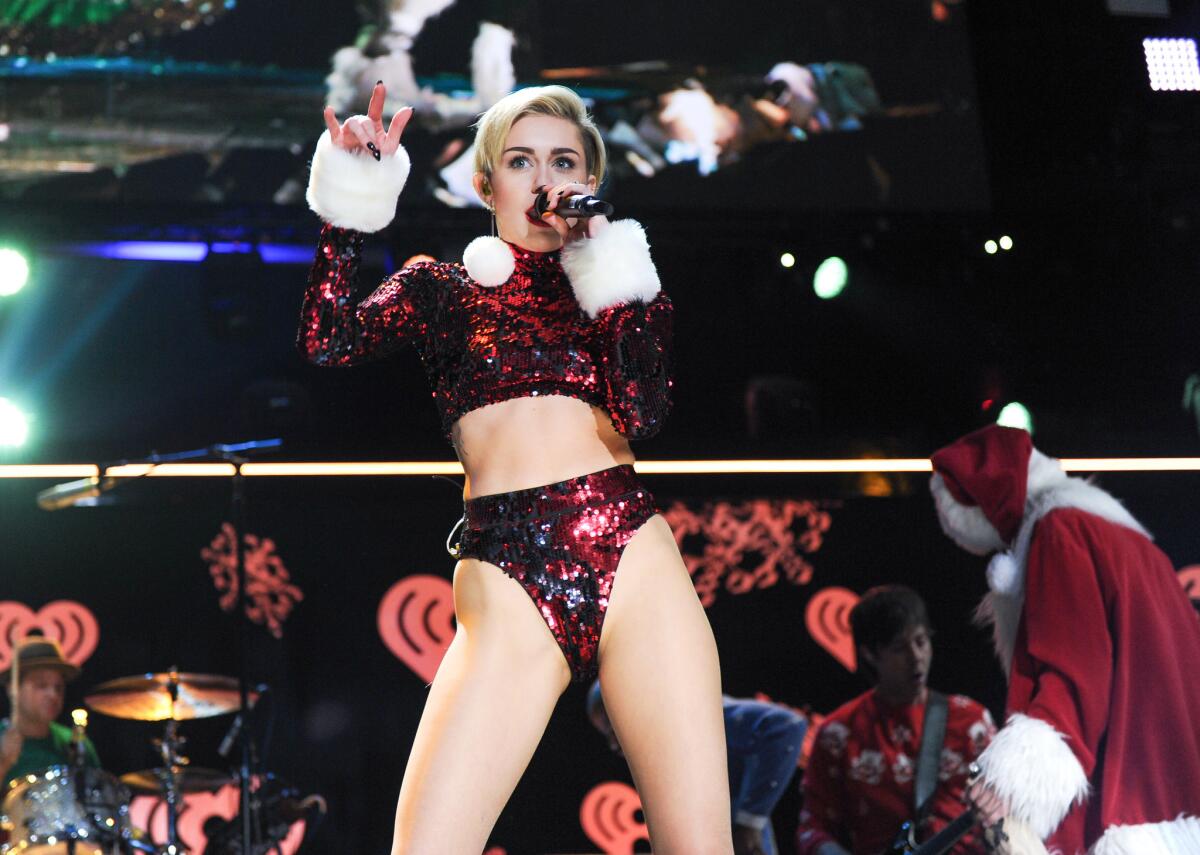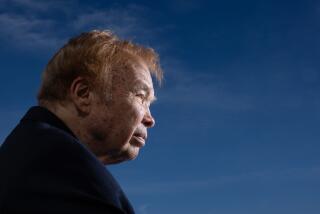The real story behind Miley Cyrus’ ‘Free the Nipple’ tweet

Never underestimate the power of a pop star with more than 16 million Twitter followers.
Over the weekend, Miley Cyrus tweeted a selfie with big implications for a Los Angeles actress and moviemaker. In the photo, Cyrus pulls her Chanel sweatshirt up to reveal her breasts, bare but for two strategically placed red stars proclaiming “Merry Christmas.”
“THANK YOU NY for being one of the few states to @freethenipple,” Cyrus tweeted. Later, she added, “It’s not about getting your [breasts] out. It’s about equality.”
If you equate female nudity with equality -- and Cyrus has been adept at raising that cultural conversation lately -- it’s actually about both.
Turns out “Free the Nipple” is not just a provocative Twitter handle.
It’s the name of an upcoming feature film by the actress and political activist Lina Esco, 28, exploring what she calls “the insane war on women’s boobs.”
Monday, Esco told me her film is about a topless warrior, played by Lola Kirke, whose repeated arrests arouse the curiosity of a journalist, played by Esco. The movie takes place around the time of last year’s mass shooting in an Aurora, Colo., movie theater. “How do we allow this violence,” Esco asked, “but a girl running around topless is obscene and wrong?”
The movie was partly inspired by Esco’s freespirited best friend, Sarabeth Stroller, whose mother was kicked out of church for breastfeeding when Sarabeth was 5 months old.
“The nipple is the first thing we connect with when we are born,” said Esco. “It nourishes us. When did it become so obscene? I don’t understand.”
It’s an excellent question. Many consider it a civil rights issue, a violation of the equal treatment principle that is enshrined in the Constitution.
Go Topless, a Nevada group, reports that only three states explicitly ban female toplessness in public. Fourteen states have ambiguous laws, and 33 allow it. But even when it’s legal, going topless violates all kinds of cultural taboos.
“In New York, I was walking around topless and this woman told me to hide my breasts, and she was covering her kid’s eyes, like I was the worst person on the planet,” said Esco. “I said, ‘Would you rather your kid see violence than nipples and breasts?’ And she said, ‘I would rather he see all the violence in the world than this.’”
And of course, there is no controlling the sexualizing male gaze. In the early ‘90s, when Ramona Santorelli and Mary Lou Schloss won the landmark case that legalized female toplessness in New York, their expert witnesses noted that forcing women to conceal their breasts (but only the nipple and below!) reinforces the culture’s sexual obsession with breasts.
A couple of years ago, when Esco was first contemplating making a film, she took Stroller and Natalie White, a well-known artists’ and photographers’ muse, to the Occupy Wall Street encampment, where they took off their tops.
“Within 10 minutes, we had 300 people around us, like they had seen an alien, like the Beatles just came out,” said Esco. “Their cameras were shaking, they couldn’t even focus, like they had never seen this. I said, ‘They’re just boobs! Let me know when you are able to listen to what we are saying.’ After about 15 minutes, everyone chilled out.”
As Esco tells it, filming topless women in New York City, even with permits, posed a nearly insurmountable challege. When she shot on Wall Street, police told her that in spite of the law, she and her fellow actresses would have to wear pasties or strips of what look like masking tape across their breasts.
Halfway through the shoot, though, Esco decided to chance the wrath of New York’s finest.
For a topless scene in Times Square, she and her crew arrived early, mapped out their movements and, using a camera on a rickshaw, filmed it, sans pasties or masking tape. “By the time I got to the other side of Times Square, there were three cars of cops ready to chase me.”
She ran into a different problem when she tried to pose a dozen or more women at a time, topless, in pink ski masks pulled over their faces at various iconic Manhattan locations, like Washington Square Park and Times Square.
“If you are in ski masks and there’s more than three people,” she said she was told by civil rights attorney Ron Kuby, “that’s a terrorist act and you’re gonna get arrested.”
Kuby confirmed their conversation. He told me the law against masks was enacted in 1845 as a response to tenant farmers who concealed their faces as “Indians” during a revolt against landlords.
“It’s a little strange where three women can take off their shirts in public, but if they have ski masks on, they can get arrested,” he said. “But when attractive young women take their shirts off, most cops are not looking at their head gear.”
Kuby, who has represented dozens of defendants against public nudity charges, won nearly $75,000 for Holly Van Voast, a performance artist who was arrested at least 10 times and even sent by police for psychiatric evaluation after appearing topless in public. At police roll calls last February, New York City Police Commissioner Raymond Kelly instructed his officers, as Kuby put it, “on the proper handling of bare breasts.”
“Even if the topless display draws a lot of attention,” reported the New York Times, “officers are to ‘give a lawful order to disperse the entire crowd and take enforcement action’ against those who do not comply, the memo says.”
Esco was able to choreograph her volunteers so that it only took them 20 seconds to shed their tops, pull their masks over their faces and be photographed. (You can see some of the tableaux in the movie trailer.)
Esco, a political activist who has worked to stop the annual slaughter of dolphins in Japan that was exposed in the Oscar-winning 2009 documentary “The Cove,” has had help from many influential friends and mentors. Among them: film producer Harvey Weinstein, the photographer Spencer Tunick (known for his images that feature hundreds of nude adults in public places) and French director Lisa Azuelos, who directed Esco and Cyrus in the 2012 movie “LOL.” Azuelos put up $750,000 for “Free the Nipple,” said Esco, who is seeking an additional $250,000 at a crowdfunding site.
But even with all that help, a shout-out from Cyrus can focus attention on a small, struggling project as nothing else.
“It’s a great gift,” said Esco. “She’s so supportive. She really is an activist at heart.”
Say what you will about Miley Cyrus, but she’s starting to look like a feminist hero to me.
ALSO:
Paul Walker funeral: ‘Fast and Furious’ costars mourn actor
Mega Millions jackpot soars to $550 million to become 2nd largest
More to Read
Sign up for Essential California
The most important California stories and recommendations in your inbox every morning.
You may occasionally receive promotional content from the Los Angeles Times.











